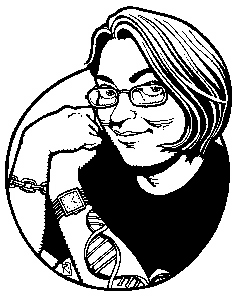![[Metroactive Features]](http://metroactive.com/features/gifs/feat468.gif)
[ Features Index | Silicon Valley | Metroactive Home | Archives ]
Just Listen
By Annalee Newitz
I'VE BEEN obsessing about weird inventions. I think it's because there's so much legislative and litigious crap going on right now that limits the ways people can invent. The Induce Act, for instance (under whatever name it has this week), would prevent people from creating media devices that might somewhere down the line tempt a consumer into infringing copyright.
And don't even get me started on the Acacia patent lawsuits. Scamster company Acacia owns several patents that it claims cover the process of streaming media over the Internet. So their business strategy is to sue hundreds of porn sites and educational institutions who are hosting movies and online classes respectively.
What happens in a world where arbitrary limits are placed on people's ability to create? I'll tell you: all the wacky shit that leads to genuine breakthroughs is prevented from happening.
Take the telephone, for instance. Alexander Graham Bell worked feverishly for two years, taking many weird routes along the way, to develop a device that has become the basis for long-distance communication across the globe. His main competitor, an electrician named Elisha Gray, was working on a similar device.
The two inventors met in 1875 at a Philadelphia exhibition, telephone demos in hand, attempting to entice execs from companies like Electric Telegraph into taking an interest in their ideas. Based on the excitement their work generated, it was clear the inventor of the telephone stood to earn a lot of money, as well as lasting fame. After the exhibition, Gray and Bell raced to perfect their machines and file their patents. Bell won by a hair, filing his patent hours before Gray filed his.
But Bell was not a likely candidate to invent an electrical device. He had little interest in the emerging science of electricity. Bell was a language teacher, an Englishman who came to Boston to teach deaf children to talk using a system he called Visible Speech. While he worked at the Boston School for Deaf Mutes, Bell was invited by prominent Boston lawyer Gardiner Greene Hubbard to tutor his deaf teenage daughter Mabel. Hubbard, whose intellectual interests led him to found the National Geographic Society, was fascinated by the breadth of Bell's scientific knowledge. Schooled in anatomy, physiology, music and linguistics, Bell delighted his employer by suggesting it might be possible to create a device that combined the capacities of the human ear with the power of the telegraph. Instead of mere blips, such a device would deliver the sound of a human voice over an electrical wire.
Hubbard was less than delighted, however, when he discovered that Bell's greatest passion was for his 17-year-old daughter Mabel. He finally consented to Mabel and Bell's relationship on one condition: the imaginative Bell would not be allowed to marry Mabel until after he had completed a patent for the telephone. Hubbard sweetened his ultimatum by going into business with Bell, funding his intensive research for the next two years.
Perhaps it was a peculiar circuit of desire that led Bell to experiment with the phonoautograph, a device that incorporated the severed ear of a dead man. When Bell spoke into the ear, a lever attached to a membrane in the eardrum made wave patterns on smoked glass. The photoautograph's human ear later inspired Bell to use membranes in the first telephones. While other inventors like Gray experimented with electricity, Bell focused his research on the body.
Shortly after secretly becoming engaged to Mabel, Bell discovered "variable resistance," the fundamental breakthrough that still underlies the construction of telephones today. As soundwaves press against a membrane, the membrane bulges slightly. Different sounds create different-sized bulges: thus, the membrane reacts with varying levels of resistance.
These variations can be translated into waves of electrical current that carry over a wire, and generate the same patterns of variable resistance in the membrane of a receiver. In some sense, the phone acts as an ear that "hears" electricity and translates it back into sound.
Bell's grisly forays into cyborgian listening devices like the photoautograph would no doubt be frowned on—if not outlawed—in today's current anti-invention climate. After all, he was using human body parts in experiments! Even worse, the device he aimed to invent might allow people to infringe the copyrights of sheet music owners by inducing phone users to engage in unlicensed, over-the-wire singing performances.
Of course some things never change: Bell guarded his patent jealously until it timed out in the early 20th century, at which point phones were finally democratized and entered into widespread usage.
[ Silicon Valley | Metroactive Home | Archives ]
Copyright © Metro Publishing Inc. Metroactive is affiliated with the Boulevards Network.
For more information about the San Jose/Silicon Valley area, visit sanjose.com.
![]()

Techsploits
Annalee Newitz ([email protected]) is a surly media nerd who dreams of ears.
Send a letter to the editor about this story to letters@metronews.com.
From the September 29-October 5, 2004 issue of Metro, Silicon Valley's Weekly Newspaper.